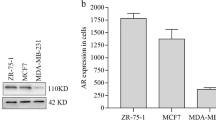Abstract
Aromatase mRNA in non-malignant breast tissues was mainly transcribed form skin fibroblast/fetal liver-specific exon 1 (exon 1b) of the aromatase gene. However, in half the cases of breast cancers, switching of the alternative exons 1 from exon 1b to ovary-specific exon 1 (exon 1c) was observed, and expression levels of aromatase mRNA in breast cancer tissues were significantly higher than those in the distal regions to tumors or in non-malignant breast tissues. Co-culture or addition of the conditioned medium of breast cancer cells, MCF-7 caused increase of aromatase mRNA in cultured adipose stromal cells from breast tissues together with switching from exon 1b to exon 1c. Removal of fetal calf serum (FCS) from the culture medium or addition of forskolin or phorbol ester (TPA) also induced rapid elevation of aromatase mRNA and switching to exon 1c, whereas TGFβ almost abolished the expression, suggesting that cancer cells might secret forskolin- or TPA-like stimulatory factors, or consume TGFβ-like inhibitory factors in serum for expression of aromatase mRNA. The promoter region responsible for transcription from exon 1b and the switching was investigated using a newly developed reporter carrying 4 major alternative exons 1 and promoters. Transcriptional elements responsible for preferential utilization of exon 1b were identified on the promoter region between − 300 and − 400 of exon 1b. Gel shift assay showed a unique site for a FCS-dependent DNA binding factor just downstream of GRE (glucocorticoid responsive element) in this promoter region.
Similar content being viewed by others
References
Means GD, Kilgore MW, Mahendroo MS, Mendelson CR, Simpson ER: Tissue-specific promoters regulate aromatase cytochrome P450 gene expression in human ovary and fetal tissues. Mol Endocrinol 5: 2005–2013, 1991
Harada N, Utsumi T, Takagi Y: Tissue-specific expression of the human aromatase cytochrome P-450 gene by alternative use of multiple exons 1 and promoters, and switching of tissue-specific exons 1 in carcinogenesis. Proc Natl Acad Sci USA 90: 11312–11316, 1993
Santen RJ: Introduction to the conference, aromatase: new perspectives for breast cancer. Cancer Res 42: 3268s, 1982
O'Neil SJ, Elton RA, Miller WR: Aromatase activity in adipose tissue from breast quadrants: a link with tumor site. Br Med J 296:: 741–743, 1988
Bulun SE, Price TM, Aitken J, Mahendroo MS, Simpson ER: A link between breast cancer and local estrogen biosynthesis suggested by quantification of breast adipose tissue aromatase cytochrome P450 transcripts using competitive polymerase chain reaction after reverse transcription. J Clin Endocrinol Metab 77: 1622–1628, 1993
Utsumi T, Harada N, Maruta M, Takagi Y: Presence of alternatively spliced transcripts of aromatase gene in human breast tissue. J Clin Endocrinol Metab 81: 2344–2349, 1996
Sasano H, Nagura H, Harada N, Goukon Y, Kimura M: Immunolocalization of aromatase and other steroidogenic enzymes in human breast disorders. Hum Pathol 25: 530–535, 1994
Santen RJ, Martel J, Hoagland M, Naftolin F, Roa L, Harada N, Hafer L, Zaino R, Santner SJ: Stromal spindle cells contain aromatase in human breast tumors. J Clin Endocrinol Metab 79:: 627–632, 1994
Esteban JM, Warsi Z, Haniu M, Hall P, Shively JE, Chen S: Detection of intratumoral aromatase in breast carcinomas. An immunohistochemical study with clinicopathologic correlation. Am J Pathol 140: 337–343, 1992
Lu Q, Nakmura J, Savinov A, Yue W, Weisz J, Dabbs DJ, Wolz G, Brodie A. Expression of aromatase protein and messenger ribonucleic acid in tumor epithelial cells and evidence of functional significance of locally produced estrogen in human breast cancers. Endocrinology 137: 3061–3068, 1996
Simpson ER, Ackerman GE, Smith ME, Mendelson CR: Estrogen formation in stromal cells of adipose tissue of women: induction by glucocorticoids. Proc Natl Acad Sci USA 78: 5690–5694, 1981
Mendelson CR, Corbin CJ, Smith ME, Smith J, Simpson ER: Growth factors suppress and phorbol esters potentiate the action of dibutyryl cyclic AMP to stimulate aromatase activity of human adipose stromal cells. Endocrinology 118: 968–973, 1986
Mendelson CR, Cleland WH, Smith ME, Simpson ER: Regulation of aromatase activity of stromal cells derived from human adipose tissue. Endocrinology 111: 1077–1085, 1982
Mahendroo MS, Mendelson CR, Simpson ER: Tissue-specific and hormonally controlled alternative promoters regulate aromatase cytochrome P450 gene expression in human adipose tissue. J Biol Chem 268: 19463–19470, 1993
Ackerman GE, Smith ME, Mendelson CR, MacDonald PC, Simpson ER: Aromatization of androstenedione by human adipose tissue stromal cells in monolayer culture. J Clin Endocrinol Metab 53: 412–417, 1981
Harada N, Yamada K: Ontogeny of aromatase messenger ribonucleic acid in mouse brain: fluorometrical quantitation by polymerase chain reaction. Endocrinology 131: 2306–2312, 1992
Harada N, Utsumi T, Takagi Y: Molecular and epidemiological analyses of abnormal expression of aromatase in breast cancer. Pharmacogenetics 5: S59–S64, 1995
Zhao Y, Nichols JE, Bulun SE, Mendelson CR, Simpson ER: Aromatase P450 gene expression in human adipose tissue: role of a Jak/STAT pathway in regulation of the adipose-specific promoter. J Biol Chem 270: 16449–16457, 1995
Zhao Y, Mendelson CR, Simpson ER: Characterization of the sequences of te human CYP19 (aromatase) gene that mediate regulation by glucocorticoids in adipose stromal cells and fetal hepatocytes. Mol Endocrinol 9: 340–349, 1995
Author information
Authors and Affiliations
Rights and permissions
About this article
Cite this article
Harada, N., Honda, Si. Molecular analysis of aberrant expression of aromatase in breast cancer tissues. Breast Cancer Res Treat 49 (Suppl 1), S15–S21 (1998). https://doi.org/10.1023/A:1006076101178
Issue Date:
DOI: https://doi.org/10.1023/A:1006076101178




